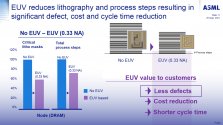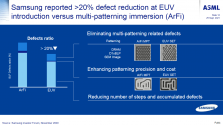If I understand correctly, the accuracy on NXT 2100i and 2050i are better than that of the earliest EUV. You can see why SMIC thinks they can do 5 nm with DUVs alone. And it is likely a lower cost process (although more labor intensive one) than using EUV. It is likely that SMIC SN1 is using mostly NXT 2000i and that SN2 is using all NXT 2050i. SN2 should be devoted to N+2 process when it's up and running.
so the deal between ASML and SMIC would've been signed at end of last year and likely NXT 2050i. It says here that $1.1 billion for 20 DUVs and many more "tens" were sold this time around. I think SMIC probably got some discount from large bulk orders, which is why that average price is lower than the overall 58.8 million EUR average sales price of ASML DUVi.
The 1.513 billion EUR sales figure most likely included a good number of dry ArF and KrF machines. But since SMEE is also competing in this segment, the vast majority (probably 85% of this sales figure) are for the more advanced immersion lithography machine. That would put the delivery figure for DUVi in H1 at closer to 25 than 30. Still a large number.
Regarding SMEE, one of the comment here caught my eyes
Looks like SMEE thinks it has (or will have) 30% of the Chinese market in the front end process (with SMIC, Huahong, GTA semiconductor and YMTC as clients) and 80% of Chinese market (and 40% of international market) in the back end process/packaging and such (with Huawei, TSMC as clients).
So for the former, I can only assume it has already shipped lithography machine to those big 4 players (at least in the SSA600 product line)
As for what SMEE has delivered. It's unknown for sure. Lot of secrecy here.
We know that 90nm SMEE lithography machine passed its certification back in 2018. However, in terms of SSA600 deliveries, they seem to have only started in 2020 to YMTC, SMIC Shaoxing and Shanghai GTA semiconductor. Those 3 seem to be 2020 orders.
Looks like since then, they have also delivered to HLMC and Huahong based on that updated client list.
Also, interesting enough, if you look at the page, it shows the amount of lithography delivery for various fabs. For HLMC fab 6, it received 7 KrF and 5 ArFi in 2019 and 2020. Since we know that Fab6 is used for 28/22 nm nm production at HLMC and the production level at fab 6 was likely 20 to 30k wpm back in 2021, it reconfirms
@tinrobert's estimate that about 10 DUVi are needed to produce 50k 28 nm 12-inch wpm. Or in this case, probably more like 10 are needed along with KrF also for 22/28 nm per 50k wpm fab.
I'm assuming they mentioned that 90 nm lithography is in mass production because SSA600 has finally been delivering for a couple of years and is now actually been used by customers. And they are likely to only have announced it, because 28 nm lithography is about to go into mass production. We know from that video, SMEE's 28 nm product was good back in 2021. That was likely equivalent to SSA600 passing certification back in 2018. It's likely still being worked out with customers right now and unlikely to be achieving same level of yield as ASML. As such, I think only Huawei is likely to use it for mass production for the next year or so. Since it probably took 3 years for SSA600 to be mass produced, it will probably take 2 years (assuming first project is always harder) for 28 nm product to reach the point where other domestic players are willing to use it for mass production. That would put timeline at 2023/2024.
So, I would say that as long ASML is able to sell, Chinese fabs are likely to continue buying their machines.


